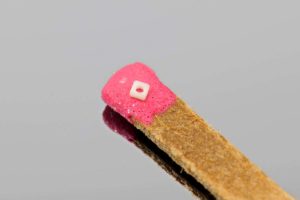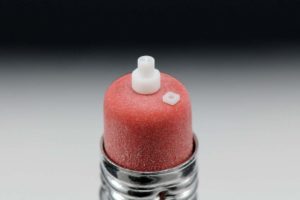Macor Machining
Although Macor® can be readily machined by using standard tools which are normally available to the average engineering shop, Macor® can also be machined in a far more cost-effective manner, a far more efficient manner, by using machines and cutting tools which are designed for machining Macor®.
Mica-Tron Products Corp. is a “state of the art” machining facility dedicated to the machining of non-metallics, including Macor®. Our capabilities include CNC turning, CNC milling,CNC drilling, and CNC grinding of Macor®, and we have all of the necessary support equipment for producing close tolerance, complex parts. Our part size capabilities range from micromachined parts, to parts that are the size of the largest blanks of Macor® currently available.
We realize that it may be necessary for customers to perform their own machining, usually on prototypes or small quantity batch runs. The following notes are intended for use when machining Macor® in small quantities and without special tools:
- Before carrying out any machining operation on Macor®, it is important to realize that Macor® is an extremely stress sensitive material. Extreme care must be used when holding Macor® in a vise or chuck, so as not to over tighten the work holding device.
- Macor® can be machined dry; however, a water soluble coolant is highly recommended to disperse heat generated during machining. If machined dry, dust collection is recommended. High speed steel tooling can be used but C2 carbide is highly recommended.
SAWING
Use a band saw with a continuous carbide grit coating and a band speed of 100 FPM (feet per minute). Alternatively, a carbon steel blade with 8 TPI (teeth per inch), or more, and a band speed of 50 FPM can be used for short run cutting, but band life will be poor.
MILLING
A cutting speed of 20 to 35 surface FPM and a chip load per tooth of .002″, with a depth of cut of .150″ to .250″, is generally acceptable. As cutting tool diameter decreases, lower chip loads and smaller depth of cut values are recommended.
TURNING
A cutting speed of 30 to 50 surface FPM with a feed rate of .001 to .005 IPR (inches per revolution) and a depth of cut of .150″ to .200″ is a good starting point for turning. As turning diameter decreases, feed rate and depth of cut should be decreased significantly.
DRILLING
Drilling can be accomplished quite nicely using a cutting speed of 75 surface FPM. Feed rates from .001 to .007 IPR work well for drills ranging from .062″ to .500″ in diameter. We do not recommend drilling holes larger than ½” in diameter without special tooling.
GRINDING
Silicon carbide grinding wheels work very well for surface grinding applications. A water soluble coolant formulated for glass or ceramic grinding must be used for all surface grinding operations.
TAPPING
We highly recommend practicing a specific tapping operation on a test piece before attempting to tap a machined part. We suggest using a tap drill that is approximately 55% of the theoretical percentage of thread recommended for a particular thread size. We also recommend that tapped holes be “through holes” and not “blind holes”. The tapping operation should be performed by turning the tap in one direction only, because turning the tap back and forth can cause chipping. Use plenty of water to lubricate the process.
All of the speeds and feeds listed are merely guidelines for customers who wish to attempt the machining of Macor® in their own shop. However, because there are far too many variables involved, no specific guideline can accurately cover all scenarios. The general rule of thumb would be: Start operations at slow feeds and speeds, and modify the values with care.
Macor® is a trademark of Corning Glass Works
View PDF on Macor®



